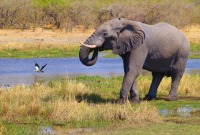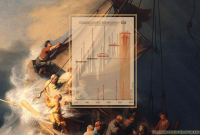Support strong Canadian climate journalism for 2025
Cocaine, pesticides and dozens more toxic chemicals choked the water covering parts of B.C.'s Fraser Valley during an unprecedented flood that hit the region last year, according to a new study, and researchers behind the findings say they are the first to reveal how the disaster impacted already struggling aquatic species like wild salmon.
The floodwaters covering the former Semá:th X̱ó:tsa, or Sumas Lake — now called Sumas Prairie — contained 379 chemical components and bacteria, researchers found. Two-thirds were created by humans, including several that aren't found in nature.
Sumas Lake was drained in 1924 to make way for farmland, destroying fish and waterfowl habitat and severely impacting First Nations who relied on the lake for food. It refilled last November after an unprecedented atmospheric river breached the dikes and powerful pumps that keep it dry.
Fertilizers, fecal matter, metals, pesticides, pharmaceuticals, tire-related chemicals and the artificial sweetener sucralose were common. Contamination from the flood paints a "disturbing picture" of the threat to fish and their habitat in the region — even when it is not flooded, the study warned.
The findings are the first time waters in the region were tested for many of the chemicals. A lack of regular tests means that governments are "flying blind" when it comes to assessing the health of the watershed, said Raincoast Conservation Foundation senior scientist Peter Ross. The environmental organization led the study alongside two Indigenous fisheries and conservation organizations, the Semá:th First Nation and the federal and provincial governments.
That lack of historical data made it difficult for the team to assess just how much the floods impacted water quality in the area, forcing them to simply figure out what was there in the weeks after the disaster. They took samples from 10 sites affected by the floods, four wells and one site upstream that served as a control.
They then tested these samples for a suite of chemicals and other toxins. Only 23 per cent of those toxins have government-assessed guidelines that establish their risk to fish, helping the researchers know if the floodwaters posed a danger or not. The environmental impacts of the remaining 293 chemicals, heavy metals and bacteria the group tested for are largely unknown, the study said.
Ross added that much of the floodwater had low levels of dissolved oxygen, which is essential for fish to survive and thrive. Dissolved oxygen levels typically crater because of aquatic algal blooms, which are triggered by high concentrations of artificial fertilizers in the water.
The flood threw the impact of these pollutants on fish into the public consciousness, but Ross said they are nothing new. Despite repeated pledges by governments to better protect salmon, the Fraser Valley's freshwater protection regime is sorely lacking.
"We're building dams and dikes and culverts, we're logging … agriculture is free to till and farm and apply pesticides right up to the water's edge," he said. Then there's Semá:th X̱ó:tsa — the former lake played a key role both in supporting fish and mitigating floods.
With future climate disasters looming, he said governments should be considering ways to bring back some of those benefits without destroying the region's farms and communities. Take the Netherlands: after a series of devastating floods on the Rhine in the 1990s, the country worked with its neighbours to rebuild natural forests and bushes along the river. This "rewilding" effort has helped reduce the risk of floods and supported biodiversity without forcing people to fully abandon the impacted areas, he said.
Murray Ned, executive director of the Lower Fraser Fisheries Alliance, one of the groups that helped with the study, agreed.
“The former Semá:th X̱ó:tsa was once relied upon by our ancestors and provided many of the resources required to sustain our people. The November 2021 flood event demonstrated that the spirit of the X̱ó:tsa is alive and well and that we must learn to harmonize with Mother Nature today."






Comments